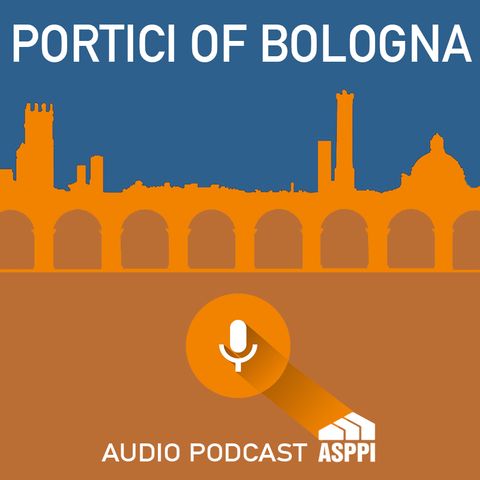Portici of Bologna. Portico of San Luca (English)

Download and listen anywhere
Download your favorite episodes and enjoy them, wherever you are! Sign up or log in now to access offline listening.
Description
The portico of San Luca. The devotional portico begins at the Bonaccorsi arch, near Porta Saragozza and ends at the Sanctuary of the Madonna of San Luca at the top...
show moreIt is a covered walkway almost 4 km in length with arches all the way, in its flat section from the Bonaccorsi arch to the Meloncello arch and from here up the hill to the Sanctuary.
The tradition of the pilgrimage to the top of the hill began in the 12th century when the Byzantine icon of the Virgin, credited to the hand of Saint Luke, was first taken there. The story was that Monks of the Basilica of Saint Sophia in Constantinopole entrusted the painted panel to a Greek hermit ordering him to take it to the Monte della Guardia, in Italy. Only when in Rome did the pilgrim find out from a prelate where the location was. Once in Bologna and welcomed by the local authorities the icon was taken by procession up the hill in 1160 and placed in the small church which was there at the time. From then on, the flow of pilgrims was remarkable and already in 1194 a new church was built, with its founding stone coming from Rome and blessed by pope Celestine III.
For centuries the walk up the hill was by mule track, only eventually paved. In 1674, in order to protect the pilgrims going to the Sanctuary, building works on the portico in the flat part of land started, financed by believers, art corporations and the noble families of Bologna. Plans and supervision of the portico of San Luca were by architect Gian Giacomo Monti who also designed the Bonaccorsi arch, the starting point of the devotional walk. For the arch he was inspired by the four-sided one with columns and pediments by Terribilia for the cistern of the Botanical Gardens (Orto Botanico), adjusting that design to make it into a solemn entrance to the devotional portico.
By 1676 the 300 rounded arches of the first section were completed and along this part of the walkway in the 1700s a was placed a statue by Andrea Ferreri of the Virgin Mary and Child which because to its grandeur and its richly draped robes is nicknamed the "Madonna grassa" (the fat Madonna).
The part on flat land, 1.5 km in length, joins the hilly section at the Meloncello arch one of the most famous architectures of Bologna built by architect Francesco Dotti in 1732. In its curved Baroque form, he created an overpass for pilgrims, held up by a lower section of rusticated low arches which allow for the pedestrian and vehicle traffic of Via Saragozza to continue to flow. In the centre of the architrave is the coat of arms of the Monti Bendini family in acknowledgement of their economic involvement in the building of the portico of San Luca and of the Meloncello arch. The layout solution, new in the local architecture blends in perfectly with its surrounding urban context and fully respects the continuity of style of the already built portico. The architect used as model the Bonaccorsi arch which we can see also repeated in the two external tribunes of the Sanctuary. At the beginning of the 20th century the arch had to be raised a few meters to allow for the electric tram line which replaced the older steam one of the Bologna-Casalecchio line.
In 1677 for the part going up the hill a human chain of people from all different walks of life, helped carry the building materials up to the top. Since 2003, every year (except for the time of the Covid pandemic) on a Saturday in mid- October, this scene is re-enacted. It is called the "Passamano per San Luca" with hundreds of school children, associations and citizens joining in to show how solidarity can help overcome difficulties. On the portico's walls are commemorative plaques and epigraphs from all time periods, both of devotional nature and to thank for donations.
The most important event takes place on the Sunday before Ascension. A procession brings the icon from the hill down to the Cathedral of Saint Peter's to commemorate a miraculous event of 1433. That was a terrible year, and the exasperated people asked the Virgin Mary to stop the incessant rain which was ruining the life-saving crops. It was decided to take the icon in procession and when it reached the outskirts of Bologna, exactly at Porta Saragozza, the rain suddenly stopped, and the sun started shining.
How many arches form the portico of San Luca? the number varies between 658 and 666 (depending on how you count them). Numerous texts give the number of 666 conjuring a connection with the occult as in the Apocalypse of Saint John, this is the number considered that of the Beast, the devil's number. The portico is seen as the long body of the snake, symbol of the Devil which ends at the Sanctuary where Mary squashes the serpent's head with her foot, marking the victory of the Church over Evil.
By Antonella Merletto Architectural historian and Official Tour Guide.
Antonella has a degree in Architecture, a post-degree specialization in Ancient Greek and Roman Architecture and a PhD in Ancient Architecture. Antonella is British-Italian and is bilingual. She teaches History of Art, History of Architecture and Archaeology in various American Universities in Rome and is an Official Tour Guide.
Information
| Author | ASPPI |
| Organization | ASPPI |
| Website | - |
| Tags |
Copyright 2024 - Spreaker Inc. an iHeartMedia Company

Comments